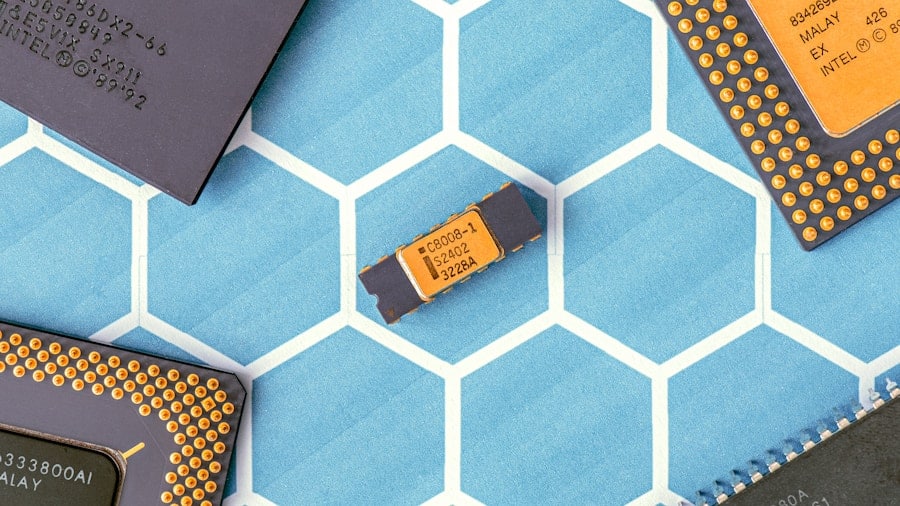The convergence of Artificial Intelligence (AI) and the Internet of Things (IoT) has catalyzed a significant transformation in the landscape of edge devices. Edge computing, which refers to the processing of data near the source of data generation rather than relying solely on centralized cloud servers, has gained traction as organizations seek to enhance efficiency and reduce latency. The proliferation of IoT devices—ranging from smart home appliances to industrial sensors—has created an unprecedented volume of data that requires real-time processing.
As a result, integrating AI capabilities into these edge devices has become essential for extracting actionable insights from the data generated. The rise of AI in edge devices is characterized by advancements in machine learning algorithms and hardware capabilities. With the advent of powerful microprocessors and specialized AI chips, edge devices can now perform complex computations locally.
This shift not only minimizes the need for constant connectivity to cloud services but also enhances the responsiveness of applications. For instance, in smart manufacturing, AI-enabled edge devices can analyze sensor data in real-time to predict equipment failures, thereby reducing downtime and maintenance costs. The synergy between AI and IoT at the edge is not merely a trend; it represents a fundamental shift in how data is processed and utilized across various sectors.
Key Takeaways
- AI and IoT are increasingly being integrated into edge devices, bringing intelligence and connectivity to the edge of the network.
- The combination of AI and IoT is revolutionizing edge computing, enabling real-time data processing and analysis at the source of data generation.
- Intelligent edge devices offer advantages such as reduced latency, improved reliability, and enhanced data security and privacy.
- However, challenges and limitations such as limited processing power and storage capacity, as well as potential security vulnerabilities, need to be addressed in AI and IoT edge devices.
- AI and IoT in edge devices have a wide range of applications, including smart cities, industrial automation, healthcare, and retail, among others.
The Impact of AI and IoT on Edge Computing
The integration of AI and IoT into edge computing has profound implications for data management and processing. Traditional cloud computing models often struggle with the sheer volume of data generated by IoT devices, leading to latency issues and bandwidth constraints. By processing data at the edge, organizations can significantly reduce the amount of information that needs to be transmitted to centralized servers.
This not only alleviates network congestion but also enhances the speed at which insights can be derived from data. For example, in autonomous vehicles, real-time decision-making is critical; edge computing allows these vehicles to process sensor data instantly, enabling them to navigate safely without relying on distant cloud resources. Moreover, the impact of AI on edge computing extends to improved data analytics capabilities.
Machine learning algorithms can be deployed directly on edge devices, allowing them to learn from local data patterns and make predictions without needing to send all data back to the cloud. This localized intelligence is particularly beneficial in scenarios where immediate responses are required, such as in healthcare monitoring systems that track patient vitals in real-time. By leveraging AI at the edge, healthcare providers can detect anomalies swiftly, leading to timely interventions that can save lives.
Advantages of Intelligent Edge Devices

Intelligent edge devices offer a multitude of advantages that enhance operational efficiency and user experience. One of the most significant benefits is reduced latency. By processing data closer to its source, intelligent edge devices can deliver insights and responses almost instantaneously.
This is particularly crucial in applications such as augmented reality (AR) and virtual reality (VR), where even slight delays can disrupt user experiences. For instance, in gaming or training simulations, intelligent edge devices can render graphics and respond to user inputs in real-time, creating a seamless experience. Another advantage is improved bandwidth utilization.
In a world where data generation is skyrocketing, transmitting vast amounts of information to centralized cloud servers can lead to bottlenecks and increased costs. Intelligent edge devices mitigate this issue by filtering and processing data locally before sending only relevant information to the cloud. This not only conserves bandwidth but also reduces operational costs associated with data transmission.
In smart cities, for example, traffic management systems equipped with intelligent edge devices can analyze traffic patterns locally and only report significant anomalies or trends to central systems, optimizing both performance and resource allocation.
Challenges and Limitations of AI and IoT in Edge Devices
Despite the numerous advantages offered by AI and IoT in edge devices, several challenges and limitations persist that organizations must navigate. One primary concern is the complexity of deploying and managing these intelligent systems. Integrating AI algorithms into edge devices requires specialized knowledge and skills that may not be readily available within an organization.
Additionally, maintaining consistency across a diverse array of devices can be daunting, particularly when dealing with different manufacturers and standards. Another significant challenge is the issue of scalability.
Organizations must ensure that their infrastructure can support a growing number of edge devices while maintaining performance levels. Furthermore, as more devices are added to the network, managing updates and security patches becomes increasingly complex. This complexity can lead to vulnerabilities if not addressed properly, making it essential for organizations to develop robust strategies for device management.
Applications of AI and IoT in Edge Devices
The applications of AI and IoT in edge devices are vast and varied, spanning multiple industries and use cases. In agriculture, for instance, intelligent edge devices equipped with sensors can monitor soil moisture levels, weather conditions, and crop health in real-time. By analyzing this data locally, farmers can make informed decisions about irrigation and fertilization, ultimately leading to increased yields and reduced resource waste.
The integration of AI allows these devices to learn from historical data patterns, optimizing agricultural practices over time. In the realm of healthcare, intelligent edge devices are revolutionizing patient monitoring systems. Wearable health monitors equipped with AI capabilities can track vital signs such as heart rate and blood pressure continuously.
By processing this data at the edge, these devices can alert healthcare providers immediately if any anomalies are detected, facilitating timely interventions. This application not only enhances patient care but also reduces the burden on healthcare systems by minimizing unnecessary hospital visits.
The Future of Intelligent Edge Devices

Enhanced Capabilities for Real-Time Applications
This will enable even more sophisticated applications that rely on real-time data processing across a multitude of connected devices. For instance, smart cities could leverage 5G-enabled intelligent edge devices for dynamic traffic management systems that adapt in real-time based on current conditions.
Advancements in AI Algorithms
Furthermore, advancements in AI algorithms will continue to enhance the intelligence of edge devices. As machine learning models become more sophisticated, they will be able to process increasingly complex datasets locally without requiring extensive computational resources.
Personalized Experiences Across Industries
This evolution will empower industries such as retail to implement personalized shopping experiences through intelligent edge devices that analyze customer behavior on-site, tailoring recommendations instantaneously based on individual preferences.
Security and Privacy Concerns with AI and IoT in Edge Devices
As organizations increasingly adopt AI and IoT technologies in their edge devices, security and privacy concerns have emerged as critical issues that cannot be overlooked. The decentralized nature of edge computing introduces new vulnerabilities that malicious actors may exploit. Unlike traditional centralized systems where security measures can be uniformly applied, securing a vast network of diverse edge devices presents unique challenges.
Each device may have different security protocols, making it difficult to ensure comprehensive protection against cyber threats. Moreover, privacy concerns arise from the vast amounts of personal data collected by intelligent edge devices. In sectors such as healthcare or smart homes, sensitive information is often processed locally before being transmitted elsewhere.
Organizations must navigate complex regulations regarding data privacy while ensuring that they implement robust encryption methods to protect user information from unauthorized access. Failure to address these concerns could lead to significant legal repercussions and damage to an organization’s reputation.
How Businesses Can Leverage Intelligent Edge Devices
To effectively leverage intelligent edge devices, businesses must adopt a strategic approach that aligns with their operational goals while addressing potential challenges. First and foremost, organizations should invest in training their workforce to develop the necessary skills for managing AI and IoT technologies effectively. This includes understanding how to deploy machine learning algorithms on edge devices as well as maintaining security protocols across a diverse array of connected systems.
Additionally, businesses should prioritize collaboration with technology partners who specialize in edge computing solutions. By leveraging external expertise, organizations can accelerate their adoption of intelligent edge devices while ensuring they remain at the forefront of technological advancements. Furthermore, establishing clear governance frameworks for data management will help organizations navigate privacy concerns while maximizing the value derived from their edge computing initiatives.
In conclusion, intelligent edge devices represent a transformative force across various industries by harnessing the power of AI and IoT technologies. As organizations continue to explore innovative applications for these technologies, addressing challenges related to security, scalability, and workforce readiness will be essential for unlocking their full potential.
In a related article, Best Free Drawing Software for Digital Artists in 2023, explores the tools available for artists to create digital art. This article delves into the various software options that can enhance the creative process for artists looking to leverage technology in their work. Just as AI and IoT are revolutionizing edge devices, digital artists can benefit from the latest software innovations to push the boundaries of their craft.
FAQs
What is AI and IoT?
AI, or artificial intelligence, refers to the simulation of human intelligence in machines that are programmed to think and act like humans. IoT, or the Internet of Things, refers to the network of physical devices, vehicles, home appliances, and other items embedded with sensors, software, and connectivity which enables them to connect and exchange data.
What are intelligent edge devices?
Intelligent edge devices are physical devices that are equipped with AI and IoT capabilities, allowing them to process data and make decisions locally, at the “edge” of the network, rather than relying on a centralized cloud or data center.
How are AI and IoT used in creating intelligent edge devices?
AI and IoT technologies are integrated into intelligent edge devices to enable them to collect and analyze data, make real-time decisions, and communicate with other devices or systems without the need for constant connectivity to a centralized server.
What are the benefits of intelligent edge devices?
Intelligent edge devices offer benefits such as reduced latency, improved security, lower bandwidth usage, and the ability to operate in environments with limited or intermittent connectivity. They also enable faster decision-making and can enhance overall system efficiency.
What are some examples of intelligent edge devices?
Examples of intelligent edge devices include smart home devices (such as thermostats and security cameras), industrial sensors and controllers, autonomous vehicles, and wearable health monitors. These devices leverage AI and IoT to perform tasks and make decisions at the edge of the network.

